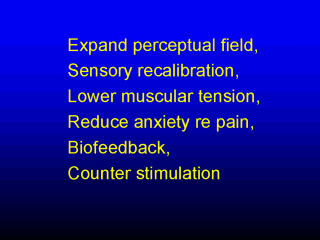| front |1 |2 |3 |4 |5 |6 |7 |8 |9 |10 |11 |12 |13 |14 |15 |16 |17 |18 |19 |20 |21 |22 |23 |24 |review |
 |
When pain is persistent, there
is a shrinkage in the perceptual field. To understand this, you need to recall the
figure-ground aspect of perception. If pain is considered to be the figure and the
perceptual field the ground, then the apparent magnitude of the figure relative to
the ground appears greater. Shrinkage of the perceptual field occurs when attention
increasingly focusses on the pain sensations to the exclusion of awareness of other
aspects of the environment. Then, relative to other aspects, pain increasingly
predominates. Conversely, by increasing the relative ratio of ground to figure, the
apparent magnitude of the pain relative to other aspects of perceptual activity is
reduced. Refer to the lecture on perception (CNS systems block) for more details of
figure-ground phenomena. Re-calibration refers to increasing the tolerance of the person to the sensory activity and involves reducing anticipatory fear and broadening the range of activities the person carries out to gradually push back the threshold at which pain tolerance is challenged. Lowering muscle tension helps, by inducing relaxation, which in itself helps reduce CNS activity associated with information processing and reduces mechanical stimulation of nociceptors which, in turn, might be exacerbating or even causing the noxious sensations. Reducing anxiety about pain has been mentioned. It is an important pain reduction strategy. Anxious people are tense and hyper-vigilant, both of which lead to increased rather than decreased processing of sensory information. Biofeedback is a technique which involves recording a biological signal and converting it to a visual or auditory form which is fed-back to the person from whom the signal is recorded. Biofeedback enables a person to quickly learn to alter a wide range of biological functions not normally amenable to voluntary control. It has been used with some limited success in pain control. Counter-stimulation (TENS) involves passing a mild electrical current between two electrodes attached to the skin over the affected area. This can be an effective aid to modifying nociceptive and collateral inhibitory sensory activity. |